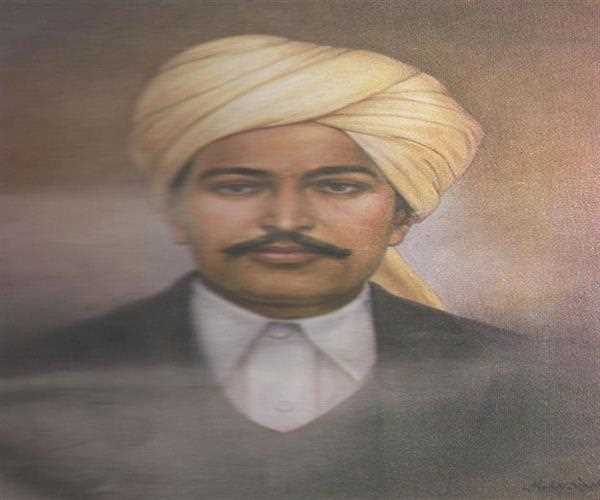Search here

22-Jun-2022 , Updated on 8/8/2022 12:30:16 AM
The assassination of Mahashay Rajpal, the publisher of Rangeela Rasool
Media is among one of the pillars of democracy and plays a very significant role in molding the opinion and perspective of the people in the society and plays an active role in bringing the accused to the hook. However, India has always struggled to retain journalists' independence and promote journalistic rights. Walking on this unpaved road has been a big challenge since the beginning. One such episode which exposed the poor condition of the media is the assassination of Mahashay Rajpal, the publisher of Rangeela Rasool.
To understand this episode, we must know what a gem of a person India lost. He is among the unsung heroes. Swargiya Mahashay Rajpal Malhotra was born into a Khatri family in Amritsar in 1885AD. From his early years, Mahashay Rajpal Ji was a very sharp, perseverant, and diligent student. But unfortunately, his father, Swargiya Lala Ramdas Khatri, drew his last breaths when he was pretty young.
In search of work, he met famous Aryasamaji Hakim Fatehchand, an Amritsar-based man who wanted to hire an employee. So he started working with Hakim Ji on a monthly income basis of twelve rupees. With his quality of duty, diligence, honesty, and perseverance, he won a special place in the heart of Hakim Ji.
In those days, Hindi was not that common in Punjab, and there were scarcely any Hindu Publishers. However, in 1912, Mahashay Rajpal Ji started 'Rajpal and Sons,' which was a Hindu Publication from Lahore. This publication covered the genres of social, political, and religious topics in 4 different languages, including Hindi, Urdu, English, and Punjabi. Rajpal Publications was bold and strong in its work and did not avoid any controversial topics, such as publishing one of India's first books on family planning titled 'Santan Sankhya ka Seema Bandhan.' Unlike now, printing newspapers and books at that time was the only way the media could reach out to the people, but that did not undermine the importance of media in democracy as it acted as the country's watchdog, the fourth pillar of democracy.
The notorious grudge between Hindu-Muslim has been going on for years. In 1920, there was a distribution of two books in the Muslim community in mosques in the entire nation titled 'Krishna Teri Gita Jalani Padegi,' 'Unnisvi Sadi Ka Lumpat Maharishi,' and 'Sita Ka Chinaala' by an anonymous author and freely distributed for 2-3 years. These disgusting texts contained vulgar and obscene sketches of Hindu deities, abuse, and vile character assassination of Lord Krishna, Dayanand Saraswati, and Ma Sita. When this incident reached the 'father of the nation,' Gandhi paid no heed to the matter but justified it by saying that all Indian citizens had the 'freedom of speech.' Imagine a leader that leads the nation justifying an incident like this. Actions speak louder than words, and this action of ignoring such an incident is a reflection of the little respect and attachment for the community he belongs to as well as the emotions of the people in it.
Every action reacts. So after three years of suppressing the deep anger and hurt, the Hindu community published two books titled 'Shaitan' and 'Rangeela Rasool' through the Public Printing press in Lahore through 'Rajpal Publishers' and the author was kept unknown. instead, the author's name there was written 'doodh ka doodh aur paani ka pani plan since the nature of the pamphlet was sensitive the actual author, Pandit Chamupati who was a well-known scholar of Koran and Islam and a close friend to Mahashay Rajpal, made a promise that he would never reveal the name of the author.
Rangeela Rasool revealed the personal details of the life of Mohammad, including his sex life and marriage, as it has been given in the Koran, which tells a surface appearance of a flattering and lyrical work on Muhammad and his teachings in it. Moreover, it was originally written in Urdu that had to be translated into Hindi, which was banned in Pakistan, India, and Bangladesh. Nevertheless, it was sold in India for one and a half years.
As expected, these two books welcomed the Muslim agitation. It's interesting how the Muslim community chose to act and express the hurt and anger that they felt after the release of the book, how they decided to ignore that what they thought at the moment was the same feeling the Hindu community had felt when they made a joke out of the religious Hindu manuscripts. Another fact that must be noted here is how easily people take the responsibility of serving justice upon themselves, which makes us contemplate on the fact how unsafe the country was and the little amount of trust they had in the British Government.
Next, after a month of distribution of these pamphlets, Gandhi, in his newspaper column 'Young India,' denounced the pamphlet and indicated that this incident was now a national issue in early 1924. The irony of the incident is that the person who denounced this Hindu pamphlet was the one who approved the books written by the Muslims. Before the second pamphlet could be printed, the colonial Government banned it in late June 1924. Soon after, Muslims filed a case against the Mahashay Rajpal under Sec 153A (promoting enmity between groups).
Righteous Man he was, Mahashay Rajpal was given the option of telling the actual author's name and going scot-free, but he refused it and kept his end of the deal. So instead, he risked his own life and remained loyal to his friend as well as the community.
The legal proceeding lasted nearly three years, after which Mr was free of all charges since the judge said that section 153A does not prohibit historical analysis of prophets of different religions. The work of numerous serious historians could also be subject to it if it were to be done. As soon as justice was delivered, the Muslim community went on a spree of threats, outrageous murders, and massacres. Maulana Mohammad Ali, one of Gandhi's favorites, announced and threatened that they would be forced to take justice into their own hands if the judgment was not reversed.
Mahashay Rajpal was now the target of the entire Muslim community. In 1927, he was acquainted with two unsuccessful attacks and was almost saved. But unfortunately, on April 6th, 1929, a 19-year-old carpenter named Ilm ud din stabbed Mahashay Rajpal brutually and ended his life. As the word of his death spread, the entire Hindu community wept their eyes out; thousands gathered to pay their condolence to the heroic departed soul who stood up for the community and sacrificed his own life for it. This might make an interesting question pop into your mind, can we find this love, commitment, and righteousness in the people of the modern Hindu community?
The killer Ilm ud din was presented and defended by the lawyer, Mohammad Ali Jinnah, who tried to prove his unexisting innocence. Currently, his grave is a religious place in Pakistan, and Pakistani textbooks eulogize him with the title of 'Ghazi.' How ironic are these two lands, opposite of each other? On one side, A man who is a murderer is worshipped in Pakistan, or a man who took the so-called revenge is celebrated in Pakistan. Here, the Hindu community grieves the death of a gem, an unsung hero who belonged to a community supported by weak leaders?
After the partition happened, Mahashay Rajpal's family moved to Delhi, from where 'Rajpal and Sons continues to work today. Mahashay Rajpal kindles inspiration for the upcoming generation and continues to inspire people today through the sacrifice he made.

Student
I look for a mix of short-term projects and long-term goals. My organizational skills allow me to successfully multitask and complete both kinds of projects. Working for you would give me the opportunity to build upon my experience and skills in data handling , content writing, financial researcher and analyst, and Product manager as part of a really inspiring and rewarding environment to work.
Join Our Newsletter
Subscribe to our newsletter to receive emails about new views posts, releases and updates.
Copyright 2010 - 2025 MindStick Software Pvt. Ltd. All Rights Reserved Privacy Policy | Terms & Conditions | Cookie Policy